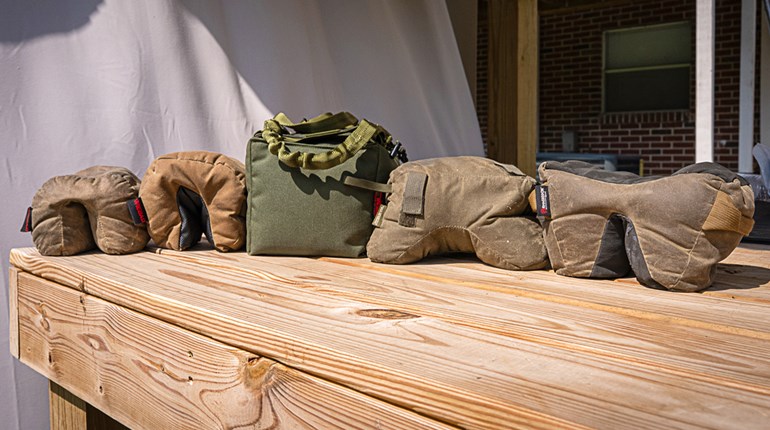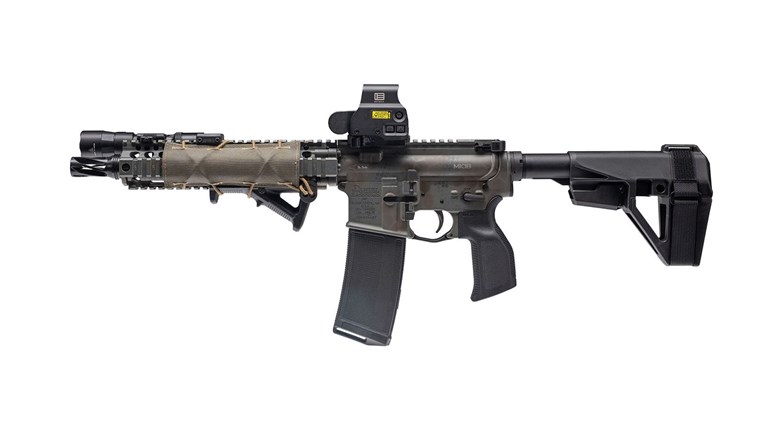
Depending on when the count is initiated, the modern sporting rifle (MSR) is entering either a sixth or seventh decade of widespread utility, if not yet across-the-board popularity. Against the first—utility—the arguments are as varied and imaginative as they are incorrect: A count of available calibers alone would seem a potent refutation (we’re not sure anyone really knows, but 70 or so is defensible) and ample evidence of “street cred.” On the popularity scale, critiques are similarly iffy: From first rifle, trainer duty in .22 lr to sledgehammer hunting calibers (.45-70, for instance) and gobs of .2x, .3x, .4x and even .5x in between, entropy is hardly imminent.
Caliber versatility is by no means alone in fueling the dynamism of the MSR/AR pattern. Configuration flexibility has made a generous contribution, particularly in the last 15 years or so. The stock, sighting and handguard options that are in full flower today actually owe a good deal to the original Daniel Defense products—sling loops, rails and handguards—that began appearing in 2002. Early, willing adopters saw improved handling, versatility and accuracy (due to free-floating of the barrel), and came from every corner of the Stoner/Fremont/Sullivan user community—sporting, competition and military/law enforcement alike. Complete rifles followed with the offering of the original DDM4 in 2009.
The tale of our current feature-rich sample is therefore more easily told backward. Quite simply, the DDM4v7 shoots. We lay this off on several factors in exceptionally crafted combination. No commentary could skip over the in-house fabricated, cold hammer-forged 5.56 barrel, and Daniel Defense is one of very few manufacturers who can do this on their own behalf. Chrome-lined and constructed of chrome-moly steel, the 1:7 twist, “strength-to-weight” profile, 18-inch length, rifle-length gas system and Muzzle Climb Mitigator brake do their jobs in versatile concert.
The result is a slightly nose-heavy rifle—our preference—that is very tame, recoil-wise, and a plain nod to 3-Gun needs. The “h” (heavy) buffer no doubt helps, but so does Daniel’s Soft Touch over-molded stock, grip and foregrip. The former is a new favorite. It has just enough cheek real estate to index consistently and stay comfortable through a long shooting session, but not so much that it rolls the head/neck in a way that makes an upright head position hard to achieve. This results in improved balance during move-and-shoot challenges, staying in the optimal eye box of your sighting technology and, of course, better comfort.
The Pro version of the DDM4v7 is a winner in the looks department as Continued on page 55 well. While it carries a “rattlecan” moniker—aka, a finish from a spray can—don’t confuse this with any conception of junky or slapdash. As a blend of DD’s proprietary “Tornado” and Mil-Spec/Cerakote in a subtly scaly pattern of grays and browns, it’s as rugged as it is eye-catching.
Range evaluation produced the results we expected: versatile and superbly reliable. Light, flat-shooting 50-grainers were the only variety to not easily eclipse the MOA threshold, though they were close (and of factory confection). Otherwise, accuracy increased as projectile mass did: When we got to 69- and 77-grain match bullets, both hovered consistently below the MOA mark, and made bouncing back and forth between a pair of 6-in. plates at 400-plus yards a routinely four-out-of-five affair.
Here, our Nightforce optic showed considerable chops as well: The center of the moar reticle framed the suspended diamonds with speedy, repeatable precision. Though all our testing was with factory ammunition, we suspect the Daniel Defense barrel is easily capable of benefitting from hand-loaded ammunition for those so inclined.
We can’t claim to be surprised by the DDM4v7 Pro. It falls neatly in with dd predecessors we’ve had the pleasure—and challenge—to beat up on, and which inflicted on us the same lack of success. Fine accuracy, splendid handling and fault-free function will please nearly any shooter. If there’s a knock, it will have to take the form of a roundabout compliment: Don’t let the 3-Gun business discourage you in any way. Even if you never plan to compete with one of your own, you’ll be doing better than we could to find a remotely material flaw in the adaptable, rugged Daniel Defense.
Frank Winn has been studying arms and their relationship to tyranny, meaningful liberty and personal security all his adult life. He has been a firearms safety/shooting instructor for more than 20 years, earned state, regional and national titles, and holds Master or Grand Master rank in several competitive disciplines.
Nuts And Bolts
Trigger — Trigger options can be a ready joy or a thorny conundrum in MSRs. Literally dozens of options from as many manufacturers allow precise selection for press weight, shoe geometry, and one- or two-stage actuation, among many other characteristics. The flip side of all these choices is that they can be a real distraction unless you’ve: a) experimented with them in the past or have an opportunity to do so now; and b) have a clear resultant notion of “what” and “how much” of any given feature mix meets your needs.
From a manufacturer’s point of view, there are two ways to skin this cat. Less-expensive rifles generally feature safe and reliable (but comparatively heavy) mil-spec triggers of reasonable quality but ho-hum feel. These embody a straightforward change-it-to-whatever-you-like message, and leave some money in your pocket to pursue the best option for you. Hidden benefit: You’ll have backup lockwork that you know works in that rifle. That’s not illogical by any means.

The other (and Daniel’s) alternative is in keeping with the competition orientation of the DDM4V7—a straight-bow Geissele Automatics Super Dynamic 3-Gun trigger of “holy smokes!” quality. As a factory-installed, one-and-done choice/recommendation, it’s very tough to fault. The 2.5-pound break and extremely positive reset of our sample was as versatile as it was superb: The up-close, rapid pairs so valued in short courses didn’t sabotage the requisite delicacy needed for longer—even much longer—shots. That’s a profound treat.
Optic — Nightforce’s NXS 2.5-10x42 riflescope is a near-perfect complement on top of the V7. Most obviously, it’s up to the energetic use—both frequent and hard—that the DDM4 all but compels. Yet enthusiastic approval doesn’t stem from mere ruggedness.
We say this knowing the guffaws of active 3-gunners will be only picoseconds behind: “But that’s what 1-6x and 1-8x FFPs were designed for!” For the record, we agree. (See our October A1F review of JP’s GMR-15 for a superlative Nightforce alternative along “pure” 3-gunning lines.) But we’re also persuaded that the additional 2x magnification will be welcome when the allure of shooting the quick-twist bore of the V7 at longer ranges and with heavier bullets asserts itself. And it will.
The Nightforce’s list of other attributes is as daunting as its performance. Beyond positively glistening optical clarity, it doesn’t take long to see the advantages of the MOAR pattern reticle. Red- or green-illuminated, it is marked to 20 MOA left/right for windage, and 10 up/30 down for elevation in one-MOA increments. Parallax adjustment, 1/4-MOA clicks and ZeroStop turrets facilitate a precise and restorable zero. Rapid magnification changes can be made by installing the optional PTL (power throw lever), though the excellent knurling texture suited us just fine and presented no snag hazard.
While actual 3-gunners are likely to choose something else, all the excellences of the NXS 2.5-10x42 on the Daniel will do many MSR riflemen and riflewomen proud indeed.


































